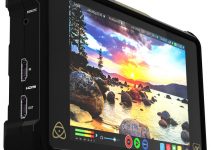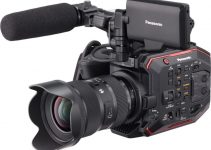When you put them side-by-side, the Canon 1DX Mark II and the 1DX Mark III look an awful lot alike. A little too much alike if you ask me. Actually now that I mention it, I can barely tell them apart at all. Which one do I shoot? WHICH ONE DO I SHOOT?!
Aside from that extra mark, they are 98% identical externally. How do you know which one is the right one, and which one is the evil one when neither is wearing a mustache?
Fortunately, that critical decision of ‘who gets the bullet’ just got a little easier thanks to the folks at LensProToGo. They’ve broken down the key differences between these doppelgängers to help you determine if this upgrade is worth it for you.
Honestly, you could be holding these cameras in your hand and not really notice the difference. Physically they are nearly identical; that’s because the camera body of the 1DX II is really fantastic. There are a few minor upgrades, however.
Canon 1Dx III Physical Upgrades:
- Cfexpress Card Slot
- Optical AF Smart Controller
- Illuminated Buttons
- Fully Functional Touch Screen
Other than the inclusion of the Dual Cfexpress card slots, the more responsive optical AF smart controller, the rear screen’s fully functional touch-screen upgrade, and illuminated buttons, Canon shaved 90 grams of weight from the 1DX III and kept the same durable and robust weather-sealed body. With a battery and memory card, the camera now weighs 1440g (3.17 lb) compared to the 1DX II at 1530g (3.37 lb) – nothing really major to report.
Also, if you’re shooting stills exclusively, the images you’ll capture will be nearly identical between the two cameras. Both of them utilize a similar Full Frame 20.1 MP sensor, delivering those glorious 5472 x 3648 images. The Canon 1DX III features an expanded ISO range to 100-102,000 compared to the 1DXII’s top ISO of 50,000 and has some improvements in image quality in low-light but these seem to be largely processor-based.
Canon 1Dx III Processor Upgrades:
- DIGIC X Image Processor
- Native ISO Range 100-102,000
- Expanded ISO Range 50-819,200
- Up to 20 fps at 20.1 MP for up to 1000 Frames (Raw)
The 1DX III can shoot 20 stills per second vs. the 1DX II’s 14 shots per second, which could make the world of difference for a sports photographer or a member of the paparazzi but the image quality is just as good. For the photographer, this might seem like a minor upgrade to an already great camera.
If you’re a cinematographer, however, put-the-gun-down because this is no evil twin. Even though the 1DX II’s 4K DCI @ 800mbps is phenomenal, the 1DXIII surpasses that video quality by leaps and bounds. The Canon 1DX III can be considered as a very professional filmmaking tool with features that rival some of Canon’s higher-end cinema line.
Canon 1Dx Mark III’s Video Features:
- 12-Bit RAW 5.5K (5472 x 2886) Full Frame Video @ up to 60fps [1800 to 2600 Mb/s] (internal)
- MP4/H.265 10-Bit 4:2:2 DCI 4K up to 60fps [170 to 1000 Mb/s]
- MP4/H.264 4:2:0 8-Bit DCI 4K up to 60fps [120 to 940 Mb/s]
- Full HD @ up to 120fps in H.265/H.264 [18 to 470 Mb/s]
- Canon Log Gamma
Canon’s only other Full-Frame camera that can film in Cinema Raw Light is the C500 Mark II ($15,999). The C500 II offers a range of features designed for serious filmmaking, but the videos that you’ll capture with the 1DX III should be virtually indistinguishable from those taken with the C500 II in the right hands, and this camera would make for an amazing B-camera or gimbal camera while shooting high-end projects with the C500 II.
Canon has also made significant improvements to the autofocusing system in the 1DX Mark III, giving it the best AF system of any high-end DSLR camera currently on the market.
Canon 1Dx Mark III’s AF Upgrades:
- EOS iTR AF X Autofocus
- 191 AF points
- Dual Pixel CMOS AF
- 3869 manually selectable autofocus points, with 525 automatic positions
- Face Detection
- Eye-AF
- Focus Guide
- Focus Peaking
Compared to the 1DX II’s 61-point High Density Reticular AF II system, the 1DX III offers 3 times the number of tracking points and a greatly expanded Dual Pixel CMOS AF that we don’t even see in most of Canon’s C cinema line.
Additional Features:
- Built-in Wi-Fi, Bluetooth, and GPS
- Photo Transfers to Mobile
- Internal Time-Lapse Recording
- Optimized the processing power / battery performance
The 1DX III is purpose-built with the future in mind, for the stills photographer with a need for serious video features. News, broadcast, documentary, independent filmmaking – the 1DX III can do it all.
If outstanding video capture is paramount to you and your work, the question of is the 1DxIII worth upgrading should be a complete no-brainer. This is by far the most advanced, most capable video DSLR ever built.
So can you tell them apart now? Which one do you shoot? The trusty, professional stills camera or the video camera in disguise with the evil-mustache?
The Canon 1DX Mark III is priced at $6,499 and the Canon 1DX Mark II is currently selling for $4,999. Head over to LensProToGo, and give the 1DX III a test drive on your next shoot.
[source: LensProToGo]
Order Links:
Canon EOS-1D X Mark II DSLR Camera (B&H, Amazon)
Canon EOS-1D X Mark III DSLR Camera (B&H, Amazon)
Disclaimer: As an Amazon Associate partner and participant in B&H and Adorama Affiliate programmes, we earn a small comission from each purchase made through the affiliate links listed above at no additional cost to you.



